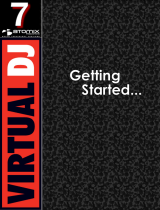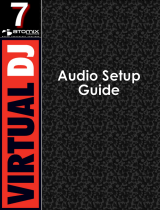Page is loading ...

VirtualDJ 8 – Quick Setup Guide
1

VirtualDJ 8 – Quick Setup Guide
2
Table of Contents
Welcome to VirtualDJ 8!........................................................................................................................... 3
Installation ................................................................................................................................................. 4
WINDOWS .............................................................................................................................................. 4
MAC ......................................................................................................................................................... 5
Opening VirtualDJ 8 for the first time..................................................................................................... 7
Installation Notes ...................................................................................................................................... 9
Application paths ..................................................................................................................................... 9
Upgrading to Version 8 ........................................................................................................................... 9
Database ............................................................................................................................................... 10
System requirements ............................................................................................................................ 11
Legal Information .................................................................................................................................... 12

VirtualDJ 8 – Quick Setup Guide
3
Welcome to VirtualDJ 8!
Overview
VirtualDJ 8 is the new, highly anticipated flagship product that will take your audio and video mixing to
a whole new level of creativity. Version 8, with its rich and innovative tools, offers the user a truly
powerful DJ software platform. It has been created to unleash all of your mixing creativity within one
DJ application. It is powerful and easy to use, equipped with all the features a DJ would want as his
favorite DJ application.
VirtualDJ 8 Features Include:
● High Quality Sound Engine: The new internal sound engine processes in high-quality 32-bit
audio.
● Sandbox: A brand new key feature allows you to prepare and test your mix, while the audience
is still listening to the master sound output.
● Sampler: With an unlimited amount of samples and banks, the user can organize audio and
video samples into banks and groups to create new samples by recording from any deck,
master or microphone input.
● Built-in Editors: A wide range of built-in editors have been added to extend the core
functionality. Examples include: Tag Editor, Track Cleaner, Video Editor, Sampler Editor, POI
Editor and BPM Editor.
● Optimized for Multi-Touch Screens and Tablets: with a custom interface tailored for the
touch experience, VirtualDJ 8 will turn your touch device into a powerful DJ controller.
● Intel Dual Personality Technology Support: With Intel Dual Personality ready devices,
VirtualDJ 8 will automatically switch based on the best suited interface to the current state of
your computer.
Let’s get started …

VirtualDJ 8 – Quick Setup Guide
4
Installation
Download the installation file
Visit your Account at http://www.virtualdj.com/users/edit.html or
http://www.virtualdj.com/download/free.html to receive the latest version of the software.
Download and save the Windows or Mac OS installation file to your computer. Navigate to the location
where you saved the downloaded installation file (most likely in your Downloads folder). Double-click on
the file: install_virtualdj_v8.0.msi (for Windows computers) or install_virtualdj_v8.pkg (for Mac OS
computers)
Follow the steps below to continue installation …
WINDOWS
1. Allow the installation to Run
2 Welcome screen … Next
3. End User License Agreement.
Please Read thoroughly. Click I Accept then Next
to agree with the terms and conditions of the
License
4. Choose Setup type
(typical is recommended)

VirtualDJ 8 – Quick Setup Guide
5
5. Ready to install … Install
6. Copying files...
7. Finish Installation … Finish
Now your software is installed and you will
find an icon on your desktop for opening
VirtualDJ
MAC
1. Click Continue to begin the installation.
2. Click Continue after reading the License
Agreement

VirtualDJ 8 – Quick Setup Guide
6
3. Click Agree to accept the License
Agreement
4. Select installation Drive .. Continue
5. Ready to Install .. Install
6. Enter your password for installing applications
7. Validating Package …
8. Configuring….

VirtualDJ 8 – Quick Setup Guide
7
9. Once files copied onto your system,
click Close to finish the installation
Now your software is installed and you should
find an icon in your Applications folder for
opening VirtualDJ 8
Opening VirtualDJ 8 for the first time
Simply double click on the VirtualDJ 8 icon on the desktop (for Windows) or your
Applications folder (for Mac OS).
On first launch a Login window will appear on top
of the VirtualDJ GUI.
VirtualDJ User Interface (Skin)
Login Window

VirtualDJ 8 – Quick Setup Guide
8
Login using the Username (or email) and the password of your current virtualdj.com account. If
you don’t’ have a virtualdj.com account, you can still login using your Google or Microsoft ID, but it is
suggested to create a virtualdj.com account.
How to Create a VirtualDJ Account
Click on the create a VirtualDJ
account button. A window will appear
to enter your personal data. Note that
VirtualDJ will never share this data or
intend to spam you.
Enter a desired Username. Notice the
side margin as you type. This will let
you know if your desired username is
available. Select a password. Type
your First and Last Name and select
your country. Next, enter your correct
email address and click on the Send
confirmation code button. The system
will automatically send you and email
with the information you need to enter in
the Confirmation Code. Once you
recieved the email and retrieved the
confirmation Code, enter it on the
screen and click on Create my
account. Finally, click Back button to
login.
Locate your tracks from the Folders list. Drag and drop a couple of tracks on the decks
and start having fun !

VirtualDJ 8 – Quick Setup Guide
9
Installation Notes
Application paths
VirtualDJ 8 installs files into the following locations:
Default application path:
Windows: C:\Program Files\VirtualDJ\
MAC OS X: ./Applications/
Application Configuration, Plug-ins, Skins, Database, Playlist, Tracklisting, Languages and
Support Files are stored in:
Windows XP: C:\Documents and Settings\{username}\My Documents\VirtualDJ\
Windows VISTA & Windows 7 & 8: C:\Users\{username}\Documents\VirtualDJ\
MAC OS X: ./Users/{username}/Documents/VirtualDJ/
Settings are saved in:
Windows XP: C:\Documents and Settings\{username}\My Documents\VirtualDJ\settings.xml
Windows VISTA, Windows 7 & 8: C:\Users\{username}\Documents\VirtualDJ\settings.xml
MAC OS X: /Users/{username}/Documents/VirtualDJ/settings.xml
Upgrading to Version 8
When upgrading VirtualDJ 8 from prior versions, the default application path stays the same and the
application configuration, plug-in, skins, database files, and support files are copied to the appropriate
location listed above.
Upgrading from version 3 or Prior
VirtualDJ 8 will not carry forward any existing information from your current setup. You will have to
analyze and set cue points after adding your collection to the new database.
Upgrading from version 4
If possible, you should have your complete Gig Ready setup connected before running the latest
version for the first time. This will give VirtualDJ 8 the ability to build the appropriate database files
using the information from the previous version database files.
Upgrading from version 5

VirtualDJ 8 – Quick Setup Guide
10
All existing database information will be maintained. However, a new database file will be created to
accommodate the new Unicode support provided in version 6.
Upgrading from version 6
All existing database information will be maintained.
Upgrading from version 7
All existing database information will be maintained.
Database
What are the database files and what do they contain?
VirtualDJ stores track’s information and creates Database files on each Hard Drive separately.
Main Database
For the tracks stored in the primary internal Drive, VirtualDJ creates a database.xml file and a
VirtualDJ folder to save information for your created Favorite, Virtual and Filter folders in the
following location:
Name
Path
database.xml &
VirtualDJ folder
Windows : C:\Users\{Username}\MyDocuments\VirtualDJ folder
Mac OS : /Users/{Username}/MyDocuments/VirtualDJ folder
Additional Drive Databases
For tracks stored in any other Internal or External Hard Drives, VirtualDJ 8 creates for each Drive a
database.xml file and a VirtualDJ folder to save information for your created Favorite, Virtual and
Filter folders in the following location:
Name
Path
database.xml &
VirtualDJ folder
Windows : Drive Letter\VirtualDJ folder
Mac OS : /Volumes/VirtualDJ folder
How it works …
For versatility and flexibility, VirtualDJ‘s database system segments the database to each drive
attached to the system. The data is stored in the database files. VirtualDJ 8 analyzes the data about the
sound track, song length, BPM, key, etc., relative path to the file stored on the drive.
The split database design provides users of external hard drives the ability to COLD or HOT SWAP
drives between single and/or multiple systems. This allows for multiple DJs of a club, venue, or mobile
setup to utilize a single VirtualDJ installation and not have different logins in order to maintain separate,
unique databases to each DJ. The DJ can just walk in, plug in the external device, and begin playing.

VirtualDJ 8 – Quick Setup Guide
11
First time opening VirtualDJ 8 after upgrading …
VirtualDJ 8 will read the database files created with older versions and it will automatically create its
own separate ones, leaving the existing databases untouched. If an External Hard Drive is not
connected at the time of first launch, VirtualDJ 8 will then read and create a new database for this
Drive, the next time this is connected.
System requirements
Windows
Mac
Supported Operating Systems
Supported Operating Systems
- Windows XP SP3
- Windows Vista
- Windows 7 (32/64bit)
- Windows 8
- Windows 8.1
- OS X v.10.7 (Lion)
- OS X v.10.8 (Mountain Lion)
- OS X v.10.9 (Mavericks)
Minimum Hardware requirements
Minimum Hardware requirements
- Intel® Pentium® 4 or AMD Athlon™ XP
- Windows XP SP3
- DirectX compatible soundcard
- 512MB RAM
- 20MB free on the hard drive
- Intel® processor
- Mac OS X v10.7
- CoreAudio compatible soundcard
- 1024MB RAM
- 30MB free on the hard drive
Recommended Hardware requirements
Recommended Hardware requirements
- Intel® Core™ 2 or AMD Athlon™ X2
- Windows 7
- Multi-channel DirectX compatible soundcard
- 2048MB (2 GB) RAM
- 200MB free on the hard drive
- Intel® processor
- Mac OS X v10.9
- Multi-channel CoreAudio compatible soundcard
- 2048MB (2 GB) RAM
- 200MB free on the hard drive
Additional requirements for Video mixing
Additional requirements for Video mixing
- ATI™ or NVIDIA® video card w/256MB of
Dedicated DDR3 RAM
- Video card must support dual-screen output
- ATI™ or NVIDIA® video chipset w/256MB
of Dedicated DDR3 RAM
- Video card must support dual-screen output

VirtualDJ 8 – Quick Setup Guide
12
Legal Information
Website : http://www.atomixproductions.com
Website : http://www.virtualdj.com
Atomix Productions Inc.
Los Angeles, CA 90036, USA
VirtualDJ Copyright:
Copyright 1997-2014 Atomix Productions Inc.
All Rights Reserved
Number IDDN.FR.001.040012.01.R.C.2000.000.31400.
Trademarks:
The VirtualDJ Logo is a registered trademark of Atomix Productions Inc.
VirtualDJ softwareis a registered trademark of Atomix Productions Inc.
License and Restrictions:
According to the EULA (End User License Agreement) accepted by every user upon installation of
VirtualDJ:
● You MAY NOT make or distribute copies of VirtualDJ, or electronically transfer VirtualDJ from
one computer to another over a network.
● You MAY NOT decompile, reverse engineer, disassemble, or otherwise reduce VirtualDJ to less
than human perceivable form.
● You MAY NOT modify or create derivative works from VirtualDJ.
● You MAY NOT sell, rent, transfer or sublicense the software. You may not sell, rent, transfer or
sublicense hardware on which the software is installed, without written prior agreement of
Atomix Productions Inc.
Reproduction of this manual in full or in part without written permission from Atomix
Productions Inc. is prohibited.
/


